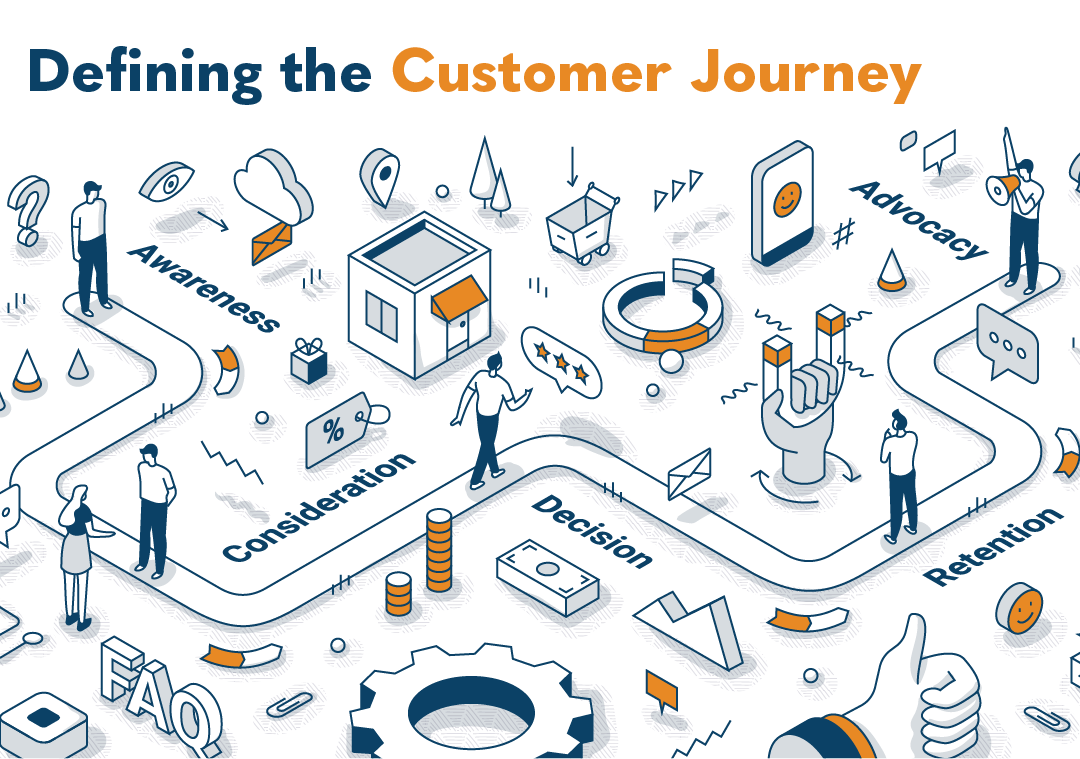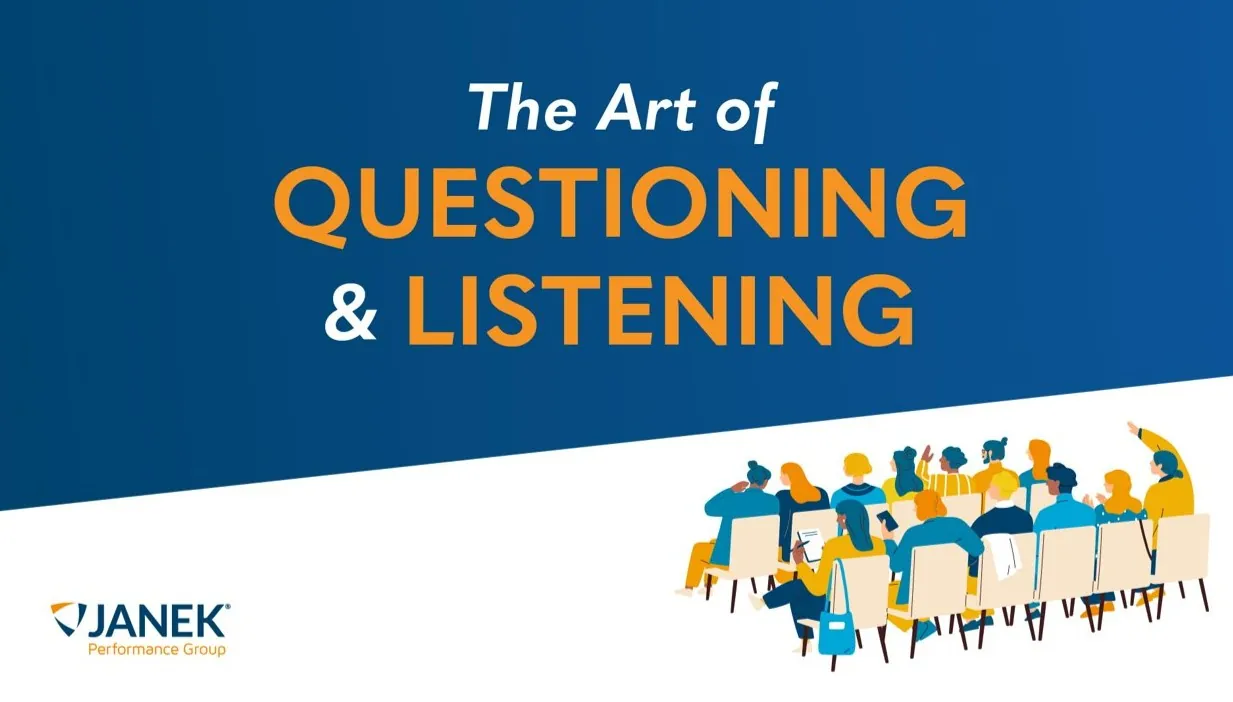Defining the Customer Journey

They say to know someone, you must walk in their shoes. However, for salespeople seeking to know and understand customers, this is impractical. All shoes are not a good fit. Instead of lacing up someone else’s shoes, it’s better to understand the customer’s journey.
As much as customers are unique, their decision making follows a similar path. Mostly, B2B buyers are not impulsive. They will not be enticed by candy in the checkout line. Instead, buyers are methodical. They follow a rational thought process. Sellers who understand this help guide customers to the solutions they need.
Generally, the buyer’s journey unfolds in five stages: awareness, consideration, conversion, loyalty, and advocacy. While sales are the goal, they are not the end of the process—not for long-term success. Our white paper, The Ultimate Guide to Developing a High-Performance Sales Organization, lists eight steps of the customer’s journey. Here, we’ll examine the steps within each stage to determine what customers think. When we understand how they think, we can target their needs. This accelerates the process and ensures win-win outcomes.
Awareness
The awareness stage is when customers first discover they have a problem. They then evaluate the situation and seek more information. Today, this is mostly done online, before buyers engage a salesperson.
In fact, recent research at Gartner shows most buyers only spend 17 percent of their time talking to sellers. This is important because buyers will form impressions, which may or may not be correct. Therefore, sellers must get beyond the buyer’s initial impressions and correct misconceptions. They must know their products and their competition’s offerings to present the best value. And they must make the most of their time with buyers.
Here are the steps of the awareness stage:
Discover: Knowing you have a problem is the first step to fixing it. While this is true, most customers do not wake up, flip a switch, and realize the bulb burnt out. Instead, the issue started earlier. Maybe, it was subtle, like a flicker. Perhaps, it was ignored. This is important for sellers because, more than the start of the customer’s need, it’s the source of their fears.
Evaluate: Here, customers determine the size and scope of their problem. Without a working light, they will be in the dark. They wonder how the problem will impact their business and personal goals.
For example, if the supply chain breaks down, how do they get widgets to customers who need widgets? Once they assess the scope of the problem, the fears follow: How will this affect revenue? Will we hit our targets? Is this goodbye to their long-awaited Hawaii trip? Remember, fear heightens need. This influences a seller’s approach when engaging the customer.
Questions buyers might consider:
- How would I characterize my goals and challenges?
- How will an effective solution impact my short- and long-term goals?
- What are the consequences of waiting to act on this problem?
If a buyer interacts with a seller during this phase, here’s how sellers should act:
- Listen more than you speak
- Provide timely and informative content, such as blogs, to highlight your expertise and experience
- Avoid anything salesy or pushy
- Display understanding and empathy
- Present yourself as a trusted advisor
Content a buyer would likely consume during their research:
- White papers
- eBooks
- Blogs
Consideration Stage
At this stage, buyers accept the reality of their problem, and they look for solutions. Here, they are less motivated by fear. Instead, they are committed to finding the very best solution. They want to solve the problem and return to normal. Often, this is when they are most likely to reach out and engage salespeople. This makes it essential sellers not only know their own products. They must also understand their competitor’s solutions. And they must be prepared to contrast these, highlighting the value of their own.
Research and Compare: In this step, customers seek solutions. Sure, they look at price. But their primary goal is finding what works. Remember, you are not the only game in town. Often, our products are comparable to others on the market. This makes your reputation and brand essential.
As a consumer, think of your feelings on known brands. There’s an extra layer of security built into your thought process. B2B buyers are no different. If the solutions are similar and the price close, most buyers will go with the name brand. This makes the right content key to guiding customers to your organization. Buyers want sellers with a proven track record of success. They want to see for themselves the results you have achieved for other, similar buyers. Here, sharing case studies with specific ROI can be extremely effective.
Questions buyers might have:
- What steps have I taken to address the issue?
- Which solutions have I encountered?
- Which solutions have I viewed as favorable and why?
- Which solutions have I dismissed and why?
Here’s how sellers should assure clients:
- Explain the differences between your own offerings and those of your competitors
- Look for those features buyers find interesting or favorable
- Provide content that highlights key aspects of your products over the competition
Content a buyer might research during this phase:
- Product sheets and webinars
- Demonstration videos
- Case studies
Conversion Stage
Here, customers have narrowed their choices to a few that may solve their problem. At this stage, the products themselves are comparable in use and functionality. Therefore, those sellers who differentiate themselves as trusted advisors will win the sale.
However, as much as buyers are motivated to find a solution, their fears may return. Sure, there’s a problem that needs solving. And it’s great to find options. But when facing two comparable solutions, how do they determine the best choice?
At this point, rather than fueling a drive, their fears may prevent decisive action. Instead of choosing, they delay, like they’re awaiting a sign. More than a lightning bolt, buyers need confirmation. They need reassurance their choice is correct. Top sellers know this stage can seem daunting for buyers. It’s when empathy and patience can make the difference.
Purchase: Once buyers feel secure, they will make a purchase. In most B2B transactions, this is more than just buying a product. It’s trusting you will be there for them as they implement the solution and beyond. It’s solidifying a partnership. From the buyer’s point of view, you are now more than a provider. You are security.
Adopt: Customers use and form initial impressions about the product they have purchased. More importantly, they get a sense of sellers and their organizations. In addition to product performance, shipment, service, and follow-up makeup the buyer’s experience. This determines if their engagement is positive. More importantly, they decide if they were right to trust you.
In this stage, sellers must understand buyers’ most common objections. Of course, these often start with price, which is usually too high. This is part of the negotiation strategy. To offset this, buyers must appreciate what they get for their money. More than a temporary stopgap, the right solution is cost effective. Rather than discounting, sellers must build value into their product.
Also, at this point, buyers no longer need products. Instead, their focus is on evaluating and comparing sellers. Those who offer the best value and partner in the buyer’s journey close the deal. They also earn trust and position themselves for long-term business.
From a short-sighted seller’s point of view, this is the end of the journey. Today, however, the stakes are too high. Buyers are better educated and have more choices. Plus, there are more decision makers, averaging between six and 10. With bottom lines, lives, and livelihoods riding on each purchase, buyers need to get it right. If the solution or service is subpar, the deal was for naught. This means the journey does not end with the purchase. For sellers, the purchase marks the transition from sales to service.
Questions buyers might ask before making a purchasing decision:
- How is the solution implemented?
- Which features do I like best?
- How satisfied will my team be with this purchase?
- What additional products and services might further improve my situation?
Here’s how the seller can assist in the decision-making process:
- Understand and counter objections
- Ensure your value proposition sets you apart from the competition
- Transition from sales to service
Content the buyer might be interested in:
- Live demos and webinars
- Case studies
- Customer reviews and testimonials
Loyalty Stage
In this stage, the sale is complete, and customers have implemented the solution. Now, sellers settle into maintaining trust, building relationships, and continuing to provide value.
Here are the steps for the buyer:
Use: As buyers implement and use your solution, they continue to form impressions. These range from ease of set up to customer support and functionality. In this step, comfort is key. As buyers are creatures of habit, their primary concern is how your solution works. Is their situation the same as before they encountered a problem? Is their situation markedly improved?
Partner: This step is critical to long-term success. Here, buyers determine how the solution affects their business and life. More than making them whole after a downturn or loss, you want them to feel stronger. Your solution not only solved a problem and restored their status quo. It improved their situation. This is when they see you as their partner. And they will return to you the next time they have a problem or seek advice.
Client questions might include:
- How satisfied am I with the product and service?
- Did I make the right decision?
- How does the solution compare to other products considered?
- What additional products and or services might further improve my situation?
Opportunities for the account manager to interact with the client:
- Follow-up calls that provide value
- Maintain contact on social media with likes, posts, and shares
- Reward loyalty with additional value, such as add-ons or extended service
Content the client might be interested in:
- Surveys
- Product how-tos
Advocacy Stage
The advocacy stage is the culmination of the buyer’s journey. This is when buyers demonstrate their recognition and appreciation for the seller’s hard work by sharing their experience.
With the internet, it’s easy to see how this affects B2C sellers. There are countless sites and forums for customers to log complaints and praise. For a restaurant, a negative review can be disastrous. The same for any mom and pop or small business owner that relies on word-of-mouth promotion.
While B2B sales are different, the effect is similar. Think of how a negative review can influence buyers during the consideration stage. You could have the best products, but a poor experience can send buyers elsewhere. Conversely, a positive experience inspires confidence. Remember, B2B buyers need security as much as products. A recommendation or endorsement goes a long way to inspiring trust. And as sellers provide this for buyers, they earn it back as well.
Share: A buyer who endorses and recommends your product and/or organization is more than a customer. They are a partner in your success. As sellers strive to be trusted advisors who share their client’s success, reciprocity is the ultimate reward. Satisfied buyers are not only willing to share their success. They are often eager to promote the sellers who helped.
Questions clients might consider:
- How would I characterize my experience with this organization and staff?
- What aspects of my experience stand out the most?
- How likely am I to recommend this seller’s products and service to others?
Actions the account manager can take:
- Check-in often
- Utilize loyalty pricing and rewards
- Ask if the client is willing to provide a testimonial and referral
Content to engage the client:
- Surveys
- Updates on new releases and previews
- Like and shares on social media
We all know that feeling of being in an unfamiliar place, unsure where to go. Anyone who has been lost in a new city or foreign country can relate. For buyers, that’s like having a problem. There’s the rush of emotions, such as shock, anger, disbelief, even denial. This is followed by a rational solution-seeking process. Often, just knowing there are solutions can help. However, it can still be tough to choose.
In all this, the last thing buyers need is someone to walk in their shoes. They want someone who can fix their problem. Of course, today’s buyers are more self-sufficient. They have the internet. They read reviews. Short of a wish-granting genie, they need a helpful guide.
However, merely solving problems is no longer enough. For long-term success, buyers need support. They need the confidence of knowing where to go next time. That’s what makes understanding the buyer’s journey so essential. You may have the knowledge, experience, and the products to help. But knowing where buyers have been, where they are, and where they are going builds trust. It means being a partner who not only shares in their success. It’s having one that also shares in yours.
For more, see The Ultimate Guide to Developing a High-Performance Sales Organization.

- Account Planning (12)
- Awards (44)
- Client Testimonial (37)
- Personal Branding (21)
- Podcast (12)
- Research (78)
- Sales Career Development (90)
- Sales Coaching (166)
- Sales Consulting (141)
- Sales Culture (180)
- Sales Enablement (382)
- Sales Leadership (116)
- Sales Management (267)
- Sales Negotiation (14)
- Sales Prospecting (138)
- Sales Role-Playing (19)
- Sales Training (243)
- Selling Strategies (281)
- Soft Skills (78)
- Talent Management (101)
- Trusted Advisor (29)
- Virtual Selling (57)
- Webinar (13)

























